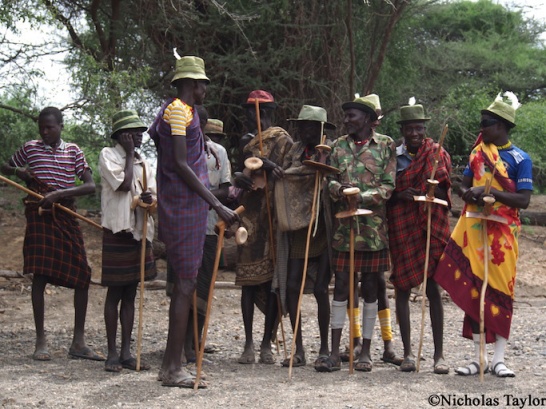The West Turkana Archaeological Project (WTAP) is a long term multidisciplinary scientific project that conducts fieldwork on the western shores of Lake Turkana in northern Kenya. Lake Turkana (formally known as Lake Rudolf) straddles the modern day border between Kenya and Ethiopia in the East African Rift Valley and covers about 6,405km² (2483 miles²), making it the world’s largest permanent desert lake. Flowing south from Ethiopia, the Omo River is the lake’s main tributary, and while there are a few other non-permanent tributaries (e.g. the Turkwel and Kerio rivers), Lake Turkana has no outlet: it is ‘endorheic’, meaning it loses water only through evaporation.
 Lake Turkana as seen from the NASA’s Space Shuttle. The sediments on western shore of the lake where the WTAP work are shown at the top of the image and in the very centre. |
 Where the WTAP work. Anticlockwise from top left: Lake Turkana in East Africa; the location of the Nachukui Formation on the west side of the lake, and (main panel) the main archaeological sites excavated by the WTAP. |
The lake is surrounded by sediments that were laid down over many tens of millions of years. These geological features – named the Nachukui, Shungura and Koobi Fora Formations – not only document important changes in the vegetation, climate, and hydrology of the region over time, but preserve alongside unique fossil and archaeological records that give crucial insights into the evolution of our early human ancestors.

The WTAP conducts research in the Nachukui Formation, which stretches approximately 100km north-south and 10km east-west along the western shore of Lake Turkana. Over the last 30 years, these sediments have revealed several major palaeoanthropological finds. Foremost amongst these are the discovery in 1984 of an almost complete fossil skeleton of a young, 7-11 year old male Homo erectus who lived about 1.5 million years ago, and in 1999 the skull of Kenyathropus platyops, a hominin (early human ancestor) that lived about 3.2 to 3.5 million years ago.
Of course, there have been many other very important discoveries made across West Turkana, including finds of Early Stone Age archaeology – the cultural remains left behind by hominins like Homo erectus, Homo habilis, and Kenyathropus Platyops. You can read and download more about some of the discoveries of stone tools and the important information they give us about human evolution here.
Climate
Turkana is not an easy place to work. The climate is very hot and dry all year-round, with peak daily temperatures frequently exceeding 36°C (95°F) in February and March and still reaching 25-30°C (75-85°F) in July and August. The difference in temperature between the lake water and surrounding land means that it is almost always windy. This is particularly welcome because there is otherwise little escape from the sun, or the heat: temperatures remain high during the night, and each 12-hour long day is filled with over 9 hours of sunshine. On average, Turkana receives only 250mm (10 inches) of rainfall a year, which falls in a unpredictable pattern, leaving the semi-nomadic pastoralist (herding) communities of Turkana facing the persistent threat of starvation. Sometimes no rain falls all year. When turkana rainstorms do hit, however, they mean business – so much rain can fall at once that the dry river beds (laggas) that criss-cross the landscape very quickly fill up and funnel all the water downstream in flash-floods. At the same time, the rain that does fall replenishes the desert; changing it from a parched and somewhat barren land to one covered in butterflies, wildflowers, green Acacia trees, and more insects than you can imagine!

People
The Turkana people that inhabit the west side of Lake Turkana – and from whom its name is derived – speak an eastern Nilotic language that they call ŋaTurkana or aŋajep a ŋaTurkana. Because Turkana is a dry and dusty semi-desert landscape that is very difficult to farm, the people who live there traditionally rely on pastoralism (animal herding) to make a living; tending to goats, sheep, and camels. These livestock provide milk, meat, and blood products, but also act as a form of currency for dowries when marriages are negotiated between families. While not a traditional pastime, nearer to the lakeshore fishing has become a common commercial activity. The largest urban and commercial centre of Turkana is Lodwar (population: ~50,000), but most of the counties’ population of 850,000 people live in or near smaller towns and villages, or more remotely, in small clusters of houses. Traditional houses are still common, and consist of a circular wooden frame of domed saplings onto which fronds of the Doum Palm tree are thatched, or animal hides and skins lashed on. They are usually large enough to house a family of six.

Today, parts of Turkana are rapidly urbanizing and many people are adopting western lifestyles and practices, including clothing. Traditionally, clothing has been used to distinguish between the age and status of individuals or groups in the Turkana community. Both men and women wear wraps made of woven fabric with rectangular patterns, and animal skins. Men usually wear these like a tunic, with one end collected together and slung over the shoulder, and also carry wrist knives made of steel and with a goat hide sheath. Men also carry stools (known as ekicholong) which they use as simple chairs and as headrests to keep off the hot sand, and often sticks used to herd their animals. Customarily, women wear similar fabrics and wear thick bead necklaces, also shaving their hair into a thin strip, colouring it and attaching beads to the ends of the longer strands.




